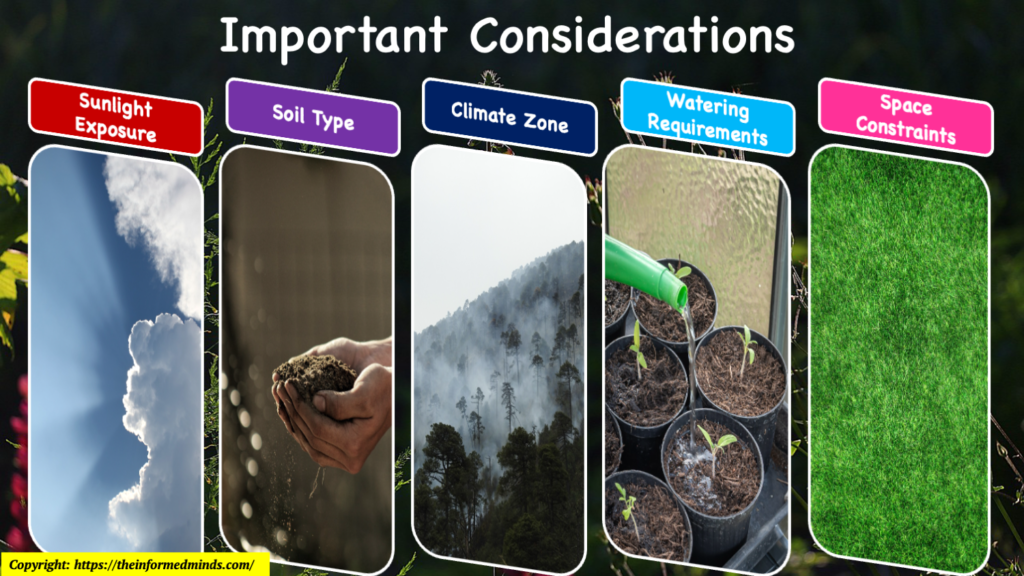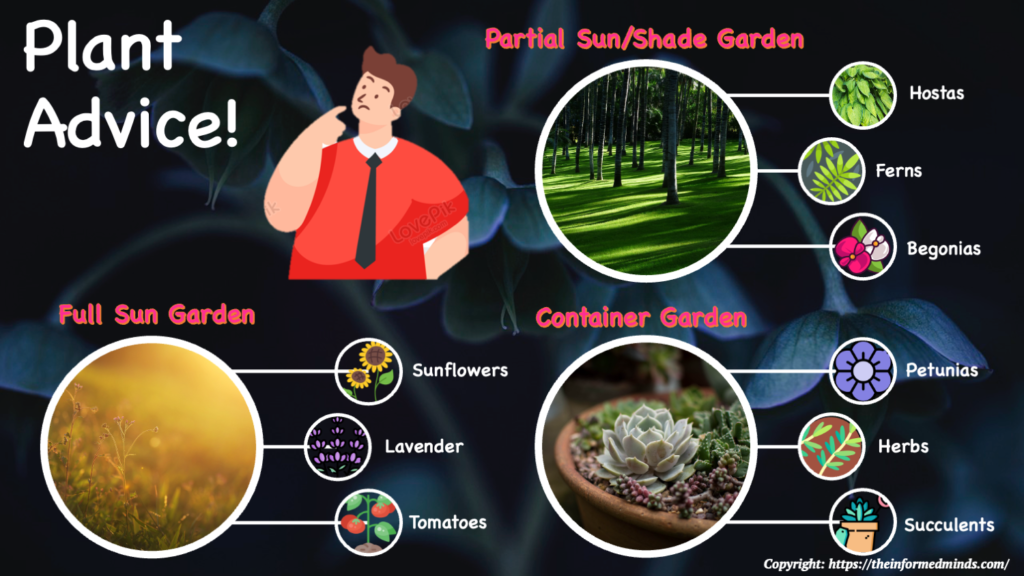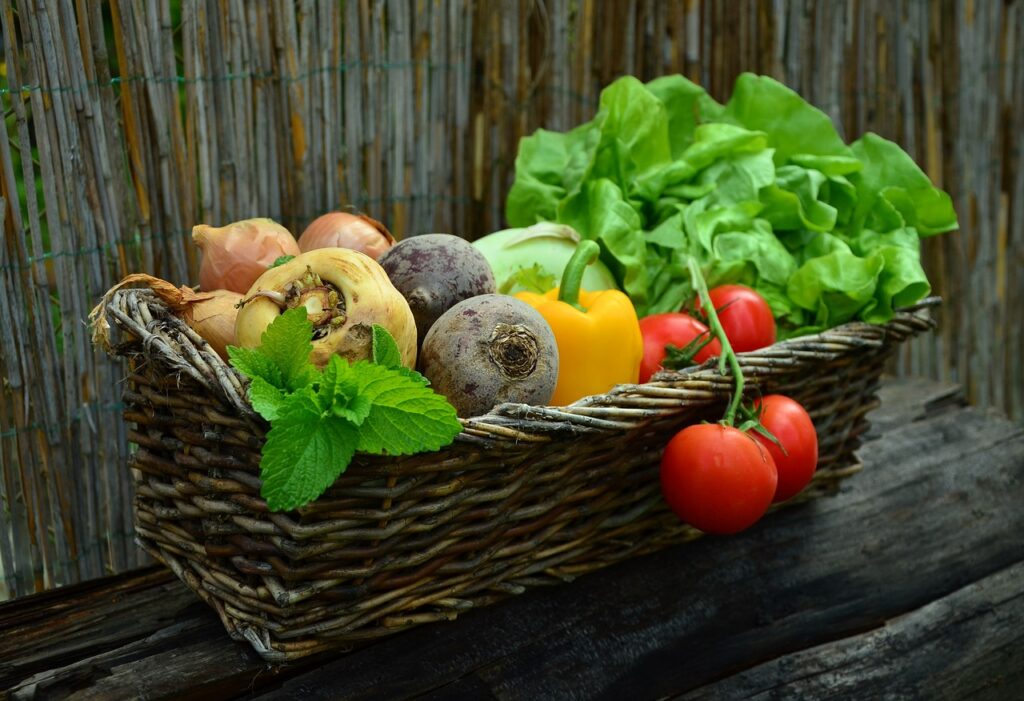To Share is to Show You Care!
In the world of gardening, choosing the right plants for your environment is crucial for a thriving and beautiful garden. Whether you have a sunny backyard, a shaded balcony, or a mix of both, understanding your environment and selecting plants accordingly can make a significant difference. In this guide, we’ll explore the key factors to consider and provide you with a comprehensive list of plant suggestions for various environments.
1. Key Factors to Consider

1.1 Sunlight Exposure
This refers to the amount of sunlight a specific area receives during the day. Full sun areas receive direct sunlight for most of the day, partial sun areas receive sunlight for a portion of the day, and shade areas receive minimal or no direct sunlight. Understanding your garden’s sunlight exposure helps you choose plants that thrive in those conditions.
1.2 Soil Type
Soil type categorizes the composition of the soil in your garden, such as sandy, loamy, or clayey. Sandy soil is well-draining but may require more frequent watering. Loamy soil is a balanced mix of sand, silt, and clay, offering good drainage and fertility. Clayey soil retains water but may need improvement for better aeration. Different plants have specific soil preferences, and choosing plants that match your soil type ensures their optimal growth.
1.3 Climate Zone
The USDA hardiness zone or climate zone indicates the climatic conditions of a specific geographic area. It’s crucial to know your zone as it helps you select plants that can withstand the average minimum winter temperatures in your region. This ensures that your chosen plants are well-suited to the local climate and have a higher chance of thriving.
1.4 Watering Requirements
Plants have varying water needs, and understanding these requirements is essential for proper care. Drought-tolerant plants are well-suited for areas with limited water availability, while moisture-loving plants thrive in consistently damp conditions. Consider your local rainfall patterns and your watering habits when choosing plants to ensure they receive the appropriate amount of water.
1.5 Space Constraints
Assessing the available space in your garden or containers is crucial to avoid overcrowding. Overcrowded plants may compete for resources and lead to poor growth. Consider the mature size of the plants you choose and plan their placement accordingly to allow for proper spacing and optimal development.
2. Plant Suggestions

2.1 Full Sun Garden
2.1.1 Sunflowers
These vibrant flowers thrive in full sunlight and are known for their cheerful appearance. Plant them in well-drained soil, and they’ll reward you with tall, colorful blooms.
2.1.2 Lavender
Ideal for sunny, well-drained areas, lavender is not only visually appealing but also drought-tolerant. Its aromatic foliage adds a pleasant fragrance to your garden.
2.1.3 Tomatoes
Sun-loving vegetables like tomatoes require ample sunlight for healthy fruit production. Ensure they receive at least 6-8 hours of direct sunlight daily.
2.2 Partial Sun/Shade Garden
2.2.1 Hostas
These versatile plants are perfect for shaded areas and come in various sizes and leaf colors. They add texture and visual interest to your garden.
2.2.2 Ferns
Flourishing in partial shade, ferns are known for their graceful fronds. They bring a touch of elegance to shaded corners or under trees.
2.2.3 Begonias
Colorful begonias thrive in shaded conditions and are excellent choices for adding pops of color to areas with less sunlight.
2.3 Container Garden
2.3.1 Petunias
These annual flowers are well-suited for hanging baskets or containers with well-draining soil. They come in various colors and provide continuous blooms.
2.3.2 Herbs (Rosemary, Thyme)
Compact and aromatic herbs like rosemary and thyme are perfect for small containers. They not only add flavor to your kitchen but also serve as ornamental plants.
2.3.3 Succulents
Drought-tolerant and visually appealing, succulents are well-suited for pots and containers. They come in various shapes and sizes, making them versatile additions to your container garden.
Conclusion
By considering factors like sunlight exposure, soil type, climate zone, watering requirements, and space constraints, you can make informed decisions when selecting plants for your garden. Remember that a well-matched plant and environment result in a healthier and more vibrant garden. Happy gardening!
Frequently Asked Questions
Q1: How do I choose the right garden plants?
A: Choosing the right garden plants involves considering factors such as sunlight exposure, soil type, climate zone, watering requirements, and available space. Assessing these elements will help you select plants that thrive in your specific gardening environment.
Q2: What are the 4 primary considerations for selecting landscape plants?
A: The four primary considerations for selecting landscape plants are sunlight exposure, soil type, climate zone (hardiness zone), and water requirements. These factors ensure that the chosen plants are well-suited to the environmental conditions of your landscape.
Q3: What are the 4 types of gardens you could plant?
A: The four types of gardens you could plant are flower gardens, vegetable gardens, container gardens, and herb gardens. Each type serves a different purpose and requires specific plant selections based on your preferences and needs.
Q4: How do you choose plant combinations?
A: Choosing plant combinations involves considering factors like color, texture, height, and blooming periods. A well-thought-out combination creates visual interest and harmony in your garden. Consider the overall design and aesthetics you want to achieve.
Q5: What is the right plant, right place theory?
A: The right plant, right place theory emphasizes selecting plants that naturally thrive in the specific environmental conditions of your garden. It encourages matching plants to their preferred sunlight exposure, soil type, and climate, promoting healthier and more resilient growth.
Q6: What is the most efficient vegetable garden layout?
A: The most efficient vegetable garden layout is the raised bed system. Raised beds provide good drainage, prevent soil compaction, and make it easier to control weeds. They also allow for efficient space utilization and better management of soil quality.
Q7: What are the 3 major principles of landscape design?
A: The three major principles of landscape design are unity, balance, and focalization. Unity ensures a cohesive and harmonious design, balance creates visual stability, and focalization directs attention to key elements in the landscape.
Q8: What are the important factors in plant selection?
A: Important factors in plant selection include sunlight exposure, soil type, climate zone, water requirements, and space constraints. Considering these factors ensures that the chosen plants are well-suited to the specific conditions of your garden.
Q9: What are the 3 major landscape factors?
A: The three major landscape factors are landform, vegetation, and water. These factors influence the overall character and design of a landscape, shaping its visual appeal and functionality.
Q10: What is the most popular garden plant?
A: The most popular garden plant can vary, but classics like roses, tulips, and sunflowers are often considered popular choices. Preferences may differ based on region and personal taste.
Q11: What plants are good for flower beds?
A: Plants that are good for flower beds include perennials like roses, daylilies, and daisies, as well as annuals such as petunias, marigolds, and zinnias. The choice depends on factors like sunlight and soil conditions.
Q12: How do you plan a garden for a family of 4?
A: Planning a garden for a family of 4 involves considering the dietary preferences, space availability, and gardening goals. Including a mix of vegetables, herbs, and flowers ensures a diverse and enjoyable garden for the whole family.
Q13: How do you group plants in a garden?
A: Grouping plants in a garden can be done based on factors like color, height, or similar water and sunlight needs. Creating plant clusters enhances visual appeal and simplifies maintenance.
Q14: Can I plant 2 different plants together?
A: Yes, you can plant two different plants together, but it’s important to consider their compatibility in terms of sunlight, water, and soil requirements. Companion planting strategies can also be employed to benefit both plants.
Q15: How many plants should you group together?
A: The number of plants to group together depends on factors like plant size, spacing recommendations, and the desired visual effect. Consider the mature size of the plants and leave enough space for them to grow without overcrowding.
The Informed Minds
I'm Vijay Kumar, a consultant with 20+ years of experience specializing in Home, Lifestyle, and Technology. From DIY and Home Improvement to Interior Design and Personal Finance, I've worked with diverse clients, offering tailored solutions to their needs. Through this blog, I share my expertise, providing valuable insights and practical advice for free. Together, let's make our homes better and embrace the latest in lifestyle and technology for a brighter future.

